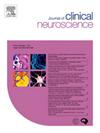Clinical characteristics of late-onset neuromyelitis optica spectrum disorder in China
IF 1.9
4区 医学
Q3 CLINICAL NEUROLOGY
引用次数: 0
Abstract
Background
Neuromyelitis optica spectrum disorders (NMOSD) are central nervous system demyelinating diseases that are distinct from multiple sclerosis. According to epidemiological studies, the incidence of NMSOD peaks in individuals aged 30–40 years. Therefore, whether the clinical manifestations and prognoses of NMOSD differ on the basis of age at onset is worthy of further investigation.
Methods
The clinical, laboratory, and imaging data of NMOSD patients admitted to Peking University Third Hospital were retrospectively analyzed. EO-NMOSD was defined early onset NMOSD (age at onset < 50 years), and LO-NMOSD was defined as late onset NMOSD (age at onset > 50 years). Differences in clinical and imaging data were compared between the two groups.
Results
A total of 75 patients with NMOSD were enrolled. Among them, 45 patients were age <50 years (EO-NMOSD), and 30 patients were age ≥ 50 years (LO-NMOSD). There was no significant difference in the EDSS score between the two groups at the time of onset (p = 0.071). The median EDSS scores at the last follow-up were 2 points and 3.5 points in the EO-NMOSD and LO-NMOSD groups, respectively, and the difference was statistically significant (p = 0.001). The proportions of patients with EDSS scores ≤ 3 points and 3 < EDSS scores ≤ 6 points were significantly different between the two groups (p = 0.023, p = 0.014), and there was no significant difference in the proportion of patients with EDSS scores greater than 6 points between the two groups (p = 1.000). Spearman correlation analysis revealed that age at onset was positively correlated with EDSS scores at onset (r = 0.284, p = 0.013) and EDSS scores at the last follow-up (r = 0.425, p = 0.000) and negatively correlated with the number of attacks (r = -0.280, p = 0.015). The proportion of AQP4-ab(+) patients with EDSS scores < 3 at onset was lower in the LO-NMOSD group than in the EO-NMOSD group (27.2 % vs. 59.5 %, p = 0.017), and the proportion of AQP4-ab(+) patients with 3 < EDSS scores ≤ 6 was greater in the LO-NMOSD group than in the EO-NMOSD group, both at onset (72.7 % vs. 32.4 %, p = 0.003) and at the last follow-up (54.5 % vs. 24.3 %, p = 0.019). In addition, the proportion of patients with hypertension in the AQP4-ab(+) group of patients with LO-NMOSD was significantly greater than that in the AQP4-ab(+) group of patients with EO-NMOSD (5.4 % vs. 27.3 %, p = 0.043).
Conclusion
LO-NMOSD patients, particularly those who were AQP4-ab positive, had more severe functional impairments and poorer prognoses. The number of attacks in AQP4-ab(+) patients with EO-NMOSD was greater than that in AQP4-ab(+) patients with LO-NMOSD.
求助全文
约1分钟内获得全文
求助全文
来源期刊

Journal of Clinical Neuroscience
医学-临床神经学
CiteScore
4.50
自引率
0.00%
发文量
402
审稿时长
40 days
期刊介绍:
This International journal, Journal of Clinical Neuroscience, publishes articles on clinical neurosurgery and neurology and the related neurosciences such as neuro-pathology, neuro-radiology, neuro-ophthalmology and neuro-physiology.
The journal has a broad International perspective, and emphasises the advances occurring in Asia, the Pacific Rim region, Europe and North America. The Journal acts as a focus for publication of major clinical and laboratory research, as well as publishing solicited manuscripts on specific subjects from experts, case reports and other information of interest to clinicians working in the clinical neurosciences.
 求助内容:
求助内容: 应助结果提醒方式:
应助结果提醒方式:


